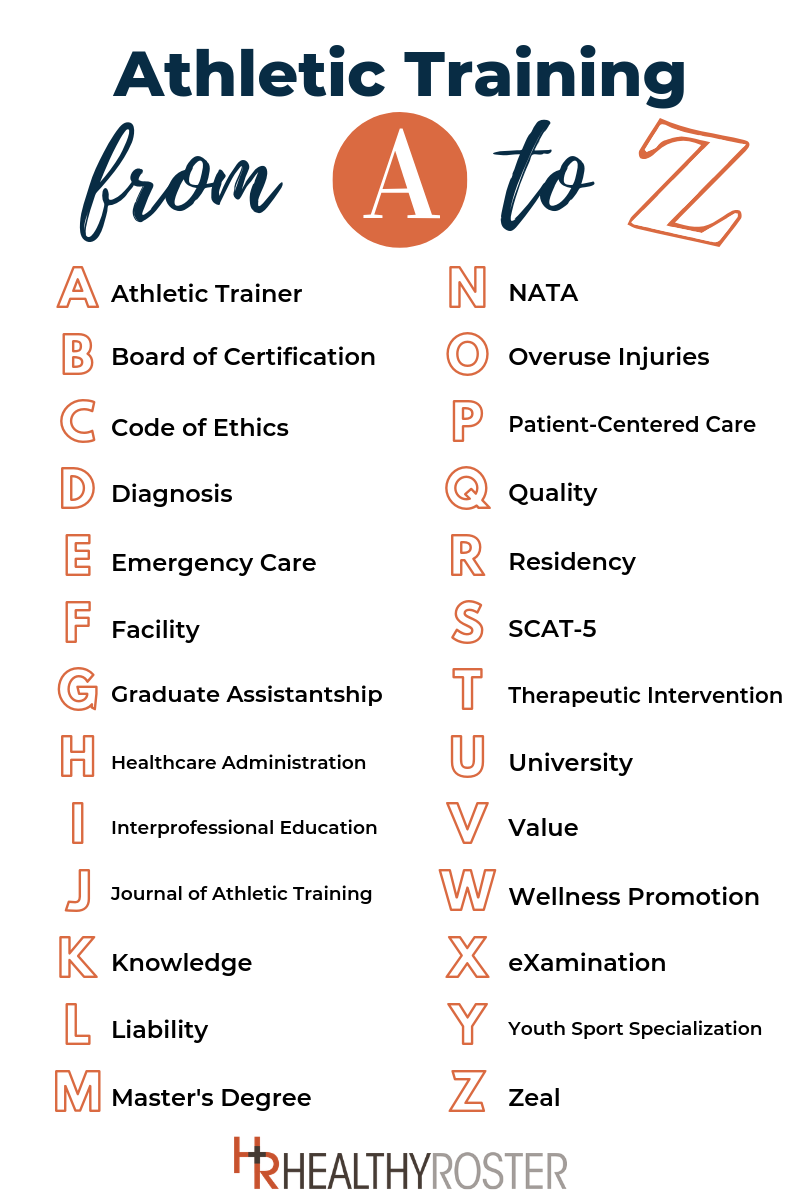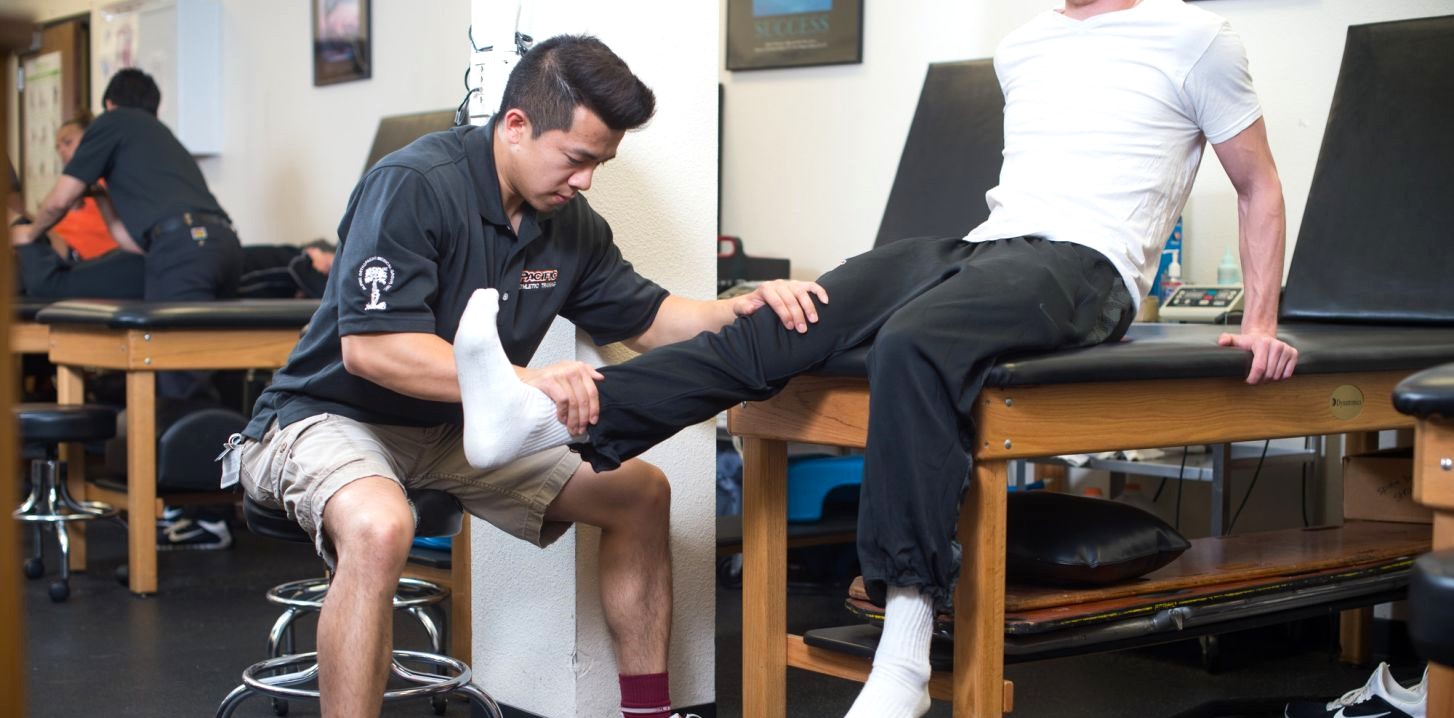Athletic Training From A to Z

Because athletic trainers interact with a variety of individuals (athletes, parents, medical directors, coaches, athletic directors, etc.) on a daily basis, it’s essential that everyone involved understands the basics of their work and the correct terminology to use when discussing it. So, pulling from a mix of industry organizations and publications, we’ve compiled an A-to-Z glossary that provides a crash course in all things athletic training.
ATHLETIC TRAINER
The preferred term is “athletic trainer” (“AT”), not “trainer,” which fails to distinguish between ATs and other professionals, such as personal fitness trainers. The National Athletic Trainers’ Association (NATA) defines athletic trainers as “health care professionals who render service or treatment, under the direction of or in collaboration with a physician, in accordance with their education and training and the states’ statutes, rules and regulations.”
BOARD OF CERTIFICATION
The Board of Certification (BOCATC) is the only accredited certification program for athletic trainers in the United States, establishing “both the standards for the practice of athletic training and the continuing education requirements for BOC Certified Athletic Trainers.” In addition to their completion of an accredited education program, prospective ATs must also pass the BOC examination.
CODE OF ETHICS
In addition to following the standards of practice outlined by the BOC, all athletic trainers must adhere to the Code of Ethics, which is maintained by NATA in order to “establish and maintain high standards and professionalism for the athletic training profession.”
DIAGNOSIS
NATA divides the athletic training profession into five domains of knowledge and services: injury prevention, clinical diagnosis, emergency care, therapeutic intervention, and healthcare administration and rehabilitation of injuries. When diagnosing a patient, an AT also develops a care plan with them, works with them to set goals, and refers them to other professionals when necessary.
EMERGENCY CARE
ATs must complete and maintain First Aid, AEP, and CPR certifications. Therefore, when an injury occurs, they are prepared to act quickly, recognize life-threatening signs and symptoms, and contact and communicate with all involved parties.
FACILITY
The preferred term for an AT’s work space is “athletic training facility,” not “training room.”
GRADUATE ASSISTANTSHIP
While pursuing graduate degrees, many prospective athletic trainers complete temporary graduate assistantships to help finance their studies.
HEALTHCARE ADMINISTRATION
Healthcare administration and rehabilitation represent one emerging setting for athletic trainers. Today, hospitals and physicians are regularly hiring ATs as part of their office staff in order to improve productivity and patient satisfaction.
INTERPROFESSIONAL EDUCATION
Athletic trainers are not done learning the moment they become certified; they are expected to continue their education and explore the most recent and up-to-date knowledge, skills, and techniques. One way to do this is through interpersonal education: “the process of learning with, about and from other health care providers.”
JOURNAL OF ATHLETIC TRAINING
The Journal of Athletic Training is a monthly peer-reviewed journal that highlights “the latest research studies pertaining to the athletic training profession.” It helps inform ATs of the latest scientific advancements define their professional standards of care.
KNOWLEDGE
Athletic trainers are expected to continue developing their knowledge well beyond the completion of their degree and certification. Their continued education should “promote continued competence, development of current knowledge and skills and enhancement of professional skills and judgment.”
LIABILITY
Because of their role in patient care, athletic trainers can be sued by a patient for negligence. Negligence cases typically involve one of three types of legal wrongdoing: nonfeasance, malfeasance, and misfeasance. NATA members have access to a liability toolkit that helps employees and employers assess the risk for negligence.
MASTER’S DEGREE
Though many accredited athletic training university programs once awarded bachelor’s degrees, by the fall of 2022, all programs accredited by the Commission on Accreditation of Athletic Training Education (CAATE) must result in the granting of a master’s degree.
NATIONAL ATHLETIC TRAINERS’ ASSOCIATION
Founded in 1950, the National Athletic Trainers’ Association is the professional membership association for certified athletic trainers and those who support the profession. Its stated mission is “to represent, engage and foster the continued growth and development of the athletic training profession and athletic trainers as unique health care providers.”
OVERUSE INJURIES
One of the biggest concerns in sports medicine today, overuse (or, chronic) sports injuries “outnumber acute injuries in almost every athletic activity.” It is speculated that more than half of these may be preventable through simple approaches.
PATIENT-CENTERED CARE
In working with patients, athletic trainers should provide “care that is respectful of and responsive to individual patient preferences, needs, and values, and ensuring that patient values guide all clinical decisions.”
QUALITY
Athletic trainers are committed to providing the highest quality of care to their patients. Therefore, they hold themselves to the Standards of Professional Practice maintained by the Board of Certification.
RESIDENCY
Designed to expand upon the knowledge acquired by an AT during their entry-level education, Post-professional Athletic Training Residency Programs are “formal educational programs that offer structured curricula and mentorship, including didactic and clinical components, to educate athletic trainers in a specialty area.”
SCAT-5
The Sport Concussion Assessment Tool (SCAT-5) is a standardized tool used by qualified healthcare professionals to establish baseline data and help evaluate athletes thought to have sustained a concussion. Every Healthy Roster profile comes with a pre-loaded SCAT-5.
THERAPEUTIC INTERVENTION
One of an athletic trainer’s domains of knowledge, therapeutic intervention focuses on returning patients to work or play injury-free. This entails recognizing their limitations and making adjustments accordingly, creating and providing options for rehab, and providing psychological care for coping and changes.
UNIVERSITY
Athletic trainers commonly work with athletic programs at colleges universities. However, contrary to popular belief, athletic trainers don’t solely work with sports programs. Other job settings for ATs include physician practices, hospitals and ERs, performing arts programs, police and fire departments, and the military.
VALUE
Demonstrating an athletic trainer’s value to society is an increasingly important aspect of the profession. NATA defines Value as “the extent to which a service’s worth is perceived by its customer to meet needs or wants.” Value doesn’t just have to do with money - AT value also comes from prevention, education, risk reduction and more. When AT’s can demonstrate their value, they can negotiate for higher pay, more resources and other well-deserved benefits. A third party study in 2018 showed that athletic trainers who use Healthy Roster generate roughly $90,000 in profit per year.
WELLNESS PROMOTION
Part of an athletic trainer’s job involves preventing injuries before they occur. This entails promoting safe practices; ensuring equipment safety; and educating patients, parents, coaches, administrators, and the public.
eXAMINATION
One of an athletic trainer’s main responsibilities is to examine their patients. This includes not only examinations following sudden or long-term injuries, but also Pre-Participation Examinations.
YOUTH SPORT SPECIALIZATION
In our increasingly competitive world, many children are choosing to put all of their eggs in one basket and specialize in a single sport from an early age. While many caregivers hope this means their child will have a better chance at becoming successful, there is evidence that encouraging athletes to not specialize too young can lead to fewer overuse injuries, less emotional and physical burn-out, and more exposure to different roles.
ZEAL
Though not a technical industry term, “zeal” undoubtedly applies to athletic trainers everywhere. ATs are dedicated and passionate, bringing energy and enthusiasm to their work every day — and treating every patient with the utmost care.
![HR Logo [Recovered]_Full Color Vertical-1](https://blog.healthyroster.com/hs-fs/hubfs/HR%20Logo%20%5BRecovered%5D_Full%20Color%20Vertical-1.png?width=199&height=178&name=HR%20Logo%20%5BRecovered%5D_Full%20Color%20Vertical-1.png)


